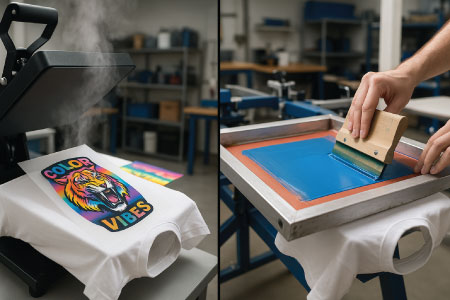In the world of custom apparel decoration, two methods dominate the conversation — DTF (Direct-to-Film) transfers and screen printing. Both techniques have loyal followings, proven results, and their own unique strengths. But if you’re running a print shop, starting a clothing brand, or simply want the best method for your designs, understanding the differences, pros, and cons of DTF transfer vs screen printing is essential.
By the end of this guide, you’ll have a clear, detailed comparison of these two popular printing methods, so you can make an informed decision for your business or personal project.
What is DTF Transfer?
DTF (Direct-to-Film) transfer is a new-age digital printing process that uses specialized printers to print designs onto a PET film. The design is then coated with a powder adhesive and cured before being transferred onto the fabric using a heat press.
Key points about DTF Transfer:
- Prints vibrant, full-color designs including gradients and photo-quality images.
- Works on a variety of fabrics: cotton, polyester, blends, canvas, denim, and more.
- No need for pre-treatment like DTG (Direct-to-Garment) printing.
- Can be stored and pressed later — perfect for wholesale or on-demand printing.
Basic DTF process steps:
- Create your design in a graphics program (e.g., Adobe Illustrator, Photoshop).
- Print onto PET film using a DTF printer with special ink.
- Apply hot-melt adhesive powder to the print.
- Cure the adhesive powder.
- Transfer the design to the garment with a heat press.
What is Screen Printing?
Screen printing, also known as silk screen printing, is one of the oldest and most widely used apparel decoration methods. It uses a mesh screen, stencil, and ink to transfer a design directly onto the garment.
Key points about Screen Printing:
- Best suited for bulk orders with fewer colors.
- Produces vibrant, long-lasting prints.
- Requires separate screens for each color in the design.
- Works well for solid color designs and vector graphics.
Basic Screen Printing process steps:
- Create and separate artwork by colors.
- Burn stencils onto mesh screens.
- Align screens onto the printing press.
- Push ink through screens onto the garment.
- Cure the ink using a dryer.
DTF Transfer vs Screen Printing — Head-to-Head Comparison
| Feature / Factor | DTF Transfer | Screen Printing |
| Setup Time | Low — No screen setup, direct digital printing | High — Screen prep and color separation needed |
| Color Capability | Unlimited colors, gradients, photo-quality | Limited colors per design (each needs a screen) |
| Fabric Compatibility | Works on cotton, polyester, blends, nylon, etc. | Best on cotton; may require additives for poly |
| Durability | Excellent — lasts through many washes | Excellent — one of the longest-lasting methods |
| Cost for Small Runs | Affordable — great for low quantities | Expensive for small orders due to setup costs |
| Cost for Large Runs | Higher than screen printing per piece | Very cost-effective for bulk orders |
| Detail Reproduction | High detail, small text, fine lines possible | Medium detail — small text may blur |
| Equipment Size | Compact printer & heat press | Large press, screens, and drying equipment |
| Learning Curve | Easier for beginners | Steeper learning curve |
| Eco-friendliness | Less waste but uses plastic films | Can be eco-friendly with water-based inks |
Advantages of DTF Transfers
- No Minimum Order Requirement – You can print just one piece cost-effectively.
- Vibrant Full-Color Prints – Unlimited colors, perfect for complex designs.
- Print Now, Press Later – You can store transfers for future use.
- Works on Multiple Fabrics – No limitation to garment type or color.
- Easier Setup – No messy screens, inks, or long prep times.
Advantages of Screen Printing
- Durability for Bulk Orders – Extremely resistant to wear and tear.
- Lower Cost for Large Quantities – The more you print, the cheaper it gets.
- Classic Look & Feel – Perfect for solid color designs and logos.
- Proven Industry Standard – A trusted method in custom apparel.
- Specialty Inks Available – Glitter, puff, metallic, and more.
Disadvantages of Each Method
DTF Transfer Disadvantages:
- Per-piece cost higher for large runs.
- Requires specialized printer and maintenance.
- Film storage needs careful handling.
Screen Printing Disadvantages:
- Not cost-effective for small orders.
- Limited to solid colors unless using advanced techniques.
- Setup time is long.
When to Choose DTF Transfer
- Small batch orders (under 50 pieces).
- Highly detailed, multi-color designs or photographs.
- Printing on multiple fabric types and colors.
- On-demand personalization or custom names/numbers.
When to Choose Screen Printing
- Large orders with minimal colors.
- Designs that need extreme durability for sportswear, uniforms.
- Classic brand logo or solid vector art.
DTF Transfer Printing for Businesses
DTF transfers are becoming the go-to choice for startup clothing brands, Etsy sellers, and local businesses. They allow for low investment, fast turnaround, and incredible flexibility. With the ability to press on demand, you can stock designs without carrying printed inventory.
Screen Printing for Businesses
Screen printing still dominates large-scale apparel production due to its speed and low per-unit cost when printing thousands of shirts. It’s perfect for corporate uniforms, promotional giveaways, and retail-level clothing.
Cost Breakdown Example
Let’s compare printing 50 T-shirts with a 5-color design:
DTF Transfer:
- Setup: Minimal
- Per piece cost: Higher ($5–$7 each depending on size & ink use)
- Total for 50: ~$300
Screen Printing:
- Setup: High (screen creation, alignment)
- Per piece cost: Low for bulk ($2–$3 each after setup)
- Total for 50: ~$200–$250 (but not cost-effective for fewer than 20 pieces)
Future of Apparel Printing
The printing industry is evolving quickly. While screen printing will always have a place in mass production, DTF transfer technology is reshaping the custom print landscape with speed, flexibility, and design freedom.
For many businesses, the future isn’t choosing one over the other — it’s offering both to meet every client’s needs.
When comparing DTF Transfer vs Screen Printing, there is no single “winner.” It all depends on:
- Order size
- Design complexity
- Fabric type
- Budget
- Turnaround time
If you want photo-quality prints, small orders, or diverse fabric options, DTF is unbeatable.
If you need large-volume printing with fewer colors at the lowest price, screen printing still reigns supreme.
For the modern print shop, offering both services ensures you capture every opportunity and satisfy every customer.

